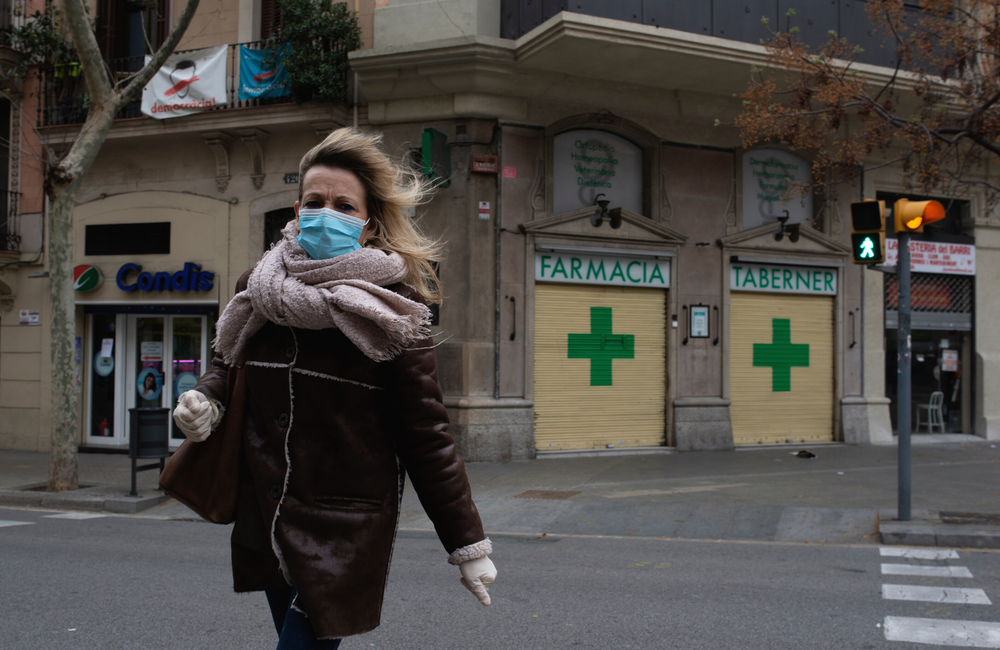
In-person healthcare visits related to HIV prevention and care decreased in number at the largest HIV care centre in Spain as a result of lockdowns during the COVID-19 pandemic. While chlamydia and gonorrhoea cases surged in 2020 compared to 2019, new HIV cases decreased by 28%. But the new HIV cases were more advanced, according to the study published in AIDS, suggesting that limited access to healthcare may have delayed patients’ HIV diagnoses.
Early in the pandemic, COVID-19 hit Spain hard with the first home lockdown beginning in March 2020 and lasting through June. Then, another wave caused a second set of lockdowns between October 2020 until May 2021.
Similar to other parts of the world, these shutdowns restricted access to healthcare and shifted priorities to caring for people ill with COVID-19, which disrupted HIV testing, prevention, and care. During the lockdowns, Spain managed care via telephone, email and virtual health sessions. Spain’s health system used the postal service and other couriers to deliver antiretroviral therapies to the homes of people living with HIV.
The researchers’ goal was to investigate how COVID-19 impacted HIV prevention, diagnosis, and care, as well as how the pandemic affected the testing and new cases of other STIs, including hepatitis B and C, syphilis, chlamydia, and gonorrhoea.
The group, led by Elisa de Lazzari, conducted a retrospective analysis using patient data from the largest HIV care centre in Spain, located in Barcelona. The centre provides care for more than 6000 people living with HIV.
The researchers compared monthly clinical data from before COVID-19 (March to December 2019) to during the pandemic (March to December 2020) to assess the impact. The data they reviewed included the number of clinical visits and screening tests conducted, test results for HIV, hepatitis B and C, syphilis, chlamydia, and gonorrhoea, and viral load levels in people living with HIV.
The group found significant decreases in outpatient clinical visits (25%) for people living with HIV, even with almost 40% of those visits conducted via telephone, email, or video conference. The number of visits related to post-exposure prophylaxis decreased 45% from 2019 to 2020. Because Spain’s National Health System first approved PrEP in November 2019, they were unable to compare how the pandemic affected PrEP visits at their clinic, but they noted the first wave of lockdowns interrupted what had been a steady increase in people seeking PrEP.
Other data also suggested that shutdowns limited engagement with healthcare. For example, the number of blood tests for cholesterol and glucose levels decreased 10% in 2020. Also, the number changes in antiretroviral therapies decreased 10%, which could indicate people had fewer opportunities to discuss side-effects or other concerns.
Despite reduced access to clinics, the number of viral load tests conducted was nearly equivalent between 2019 and 2020. Furthermore, the number of people with detectable viral loads did not change during the pandemic.
New cases of HIV went from 199 in 2019 to 143 in 2020 (a decrease of 28%), but newly-diagnosed cases were more advanced. In 2019, the mean CD4 level at diagnosis was 370 and 20 people had AIDS-defining conditions, whereas in 2020, the mean CD4 level was 305 and 26 people had AIDS-defining conditions. More advanced HIV at the time of diagnosis suggests that new cases are being detected later. These delays could be a result of interruptions in care caused by COVID-19 and could mean that the data underestimates the number of new cases in 2020.
"While the current data showed a decrease in HIV cases, more advanced HIV at diagnosis suggests delays in diagnosing new cases."
The clinic did not see significant decreases in screening tests for HIV or most STIs; in fact the numbers of gonorrhoea and chlamydia tests both increased by over 10%. While there were no significant differences in new cases of hepatitis B, hepatitis C, and syphilis, gonorrhoea and chlamydia cases each rose by almost 40% in 2020 compared to 2019. Because these results indicate that people were sexually active during lockdowns, the researchers say that this further supports their argument that new HIV cases were underestimated.
The researchers also found that people with HIV experienced higher death rates during the pandemic. In 2019, 11 people with HIV died compared to 29 in 2020. Of the 29 who died in 2020, eleven were from COVID (compared to none in 2019) and seven were from cardiovascular-related issues (compared to one in 2019). In contrast, hospital admissions for people living with HIV decreased from 486 to 429 (12%), which the researchers say could be due to COVID-19 cases occupying most hospital resources.
In summary, lockdowns caused by COVID-19 disrupted clinical visits for those with HIV and for those seeking post-exposure prophylaxis. Fortunately, this did not result in more HIV cases or worse control of viral loads. While the current data showed a decrease in HIV cases, more advanced HIV at diagnosis suggests delays in diagnosing new cases. This, coupled with increases in new cases of chlamydia and gonorrhoea, might mean this data underestimates new HIV cases. In any case, the researchers recommend that providers continue to improve their prevention and care strategies based on lessons they learned from COVID-19.
de Lazzari E et al. Impact of COVID-19 epidemics on prevention and care for HIV and other sexually transmitted infections. AIDS, online ahead of print, 11 January 2022.
doi: 10.1097/QAD.0000000000003164
